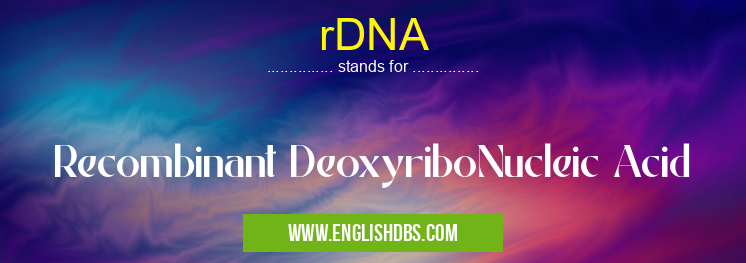What does RDNA mean in FDA
Recombinant DeoxyriboNucleic Acid (rDNA) is a form of DNA produced through the combination of two unrelated sources. It is used in biotechnology to create new genes, proteins, and other products. rDNA can be used to modify existing genes or create entirely new ones. It has opened up numerous possibilities in the healthcare industry, allowing for the creation of gene therapies and other treatments.

rDNA meaning in FDA in Governmental
rDNA mostly used in an acronym FDA in Category Governmental that means Recombinant DeoxyriboNucleic Acid
Shorthand: rDNA,
Full Form: Recombinant DeoxyriboNucleic Acid
For more information of "Recombinant DeoxyriboNucleic Acid", see the section below.
» Governmental » FDA
Essential Questions and Answers on Recombinant DeoxyriboNucleic Acid in "GOVERNMENTAL»FDA"
What is rDNA?
rDNA stands for Recombinant DeoxyriboNucleic Acid. It is a form of DNA created through the combination of two unrelated sources.
What are some uses of rDNA?
rDNA can be used to modify existing genes or create entirely new ones. It is widely used in biotechnology and healthcare applications, such as gene therapy and cell-based treatments.
How does rDNA work?
rDNA involves combining segments from different types of DNA molecules to produce a recombinant sequence that carries genetic information from each parent strand. The recombinant DNA can then be further manipulated by scientists to create new products or modify existing ones.
Is recombinant DNA safe?
Generally speaking, recombinant DNA is considered safe if it was developed according to strict safety protocols and guidelines set out by regulatory bodies such as the FDA or USDA.
What are some examples of products created using rDNA?
Examples include insulin for diabetics, human growth hormones for treating diseases like pituitary dwarfism, and vaccines for infectious diseases such as hepatitis B and HPV.
Final Words:
Recombinant DeoxyriboNucleic Acid (rDNA) has opened up numerous possibilities in biotechnology research and healthcare applications, allowing for the development of innovative treatments and cures for many conditions. As long as proper protocols are followed during its creation and use, it is considered a safe technology with wide-ranging potential.
